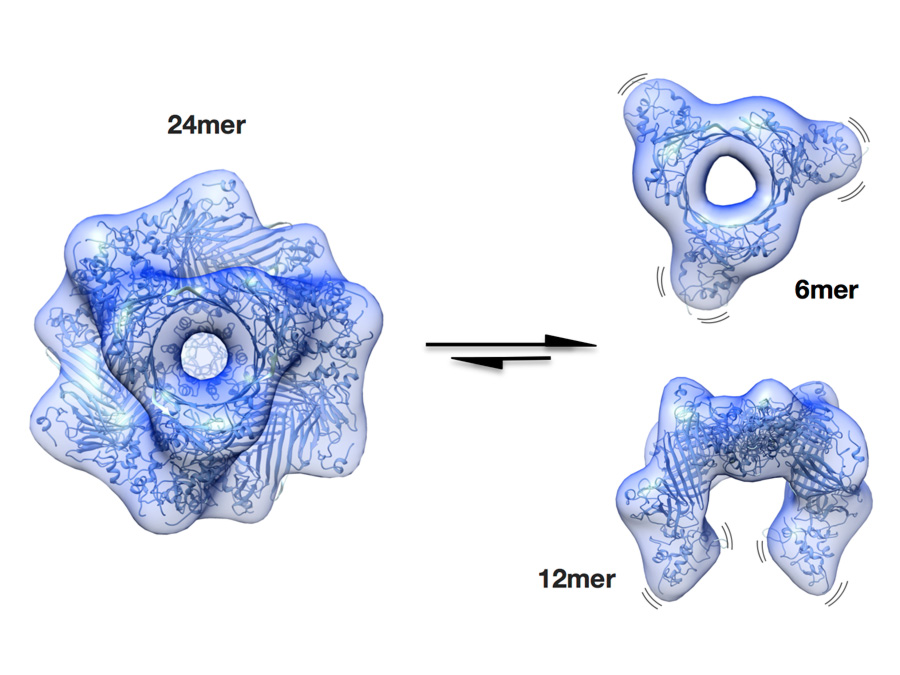Activation mechanism of a protective protein in the ocular lens resolved
A protein safeguards against cataracts

The lens of the human eye is made up of a highly concentrated protein solution that imparts the eye its high refractive power. Yet, despite this high protein content the ocular lens must remain clear and transparent. To this end ocular lens cells have developed a remarkable strategy: They have thrown overboard the complex machinery present in all other cells of the human body for building up and breaking down proteins. Instead, lens proteins are created only once in a lifetime – during embryonic development. They are as old as the organism itself. To make them last a lifetime, the proteins are kept permanently in a dissolved state. If they clump together, the lens clouds over and the patient gets cataracts.
Alternative to surgery
To date, this condition could only be treated surgically by replacing the clouded lens with an artificial one. However, if the precise mechanism by which lens proteins are kept in a dissolved state were understood, it would open up new avenues for treatment. So, how does the cell manage to keep the proteins soluble for so long? The magic lies in two proteins, αA-crystallin and its relative, αB-crystallin. They are the best-known representatives of the class of so-called small heat shock proteins. They play an important role in all human cells, since they prevent other proteins from turning into useless clumps when subjected to strong heat or cell stress.
What exactly these protective proteins look like and how they act remained shrouded in mystery for a long time, in spite of intensive research. “The great challenge in the analysis of these two crystallin types lies in their inordinate variety,” explains Johannes Buchner, professor for biotechnology at the Technische Universität München. “These proteins exist as a mixture of very different forms, each comprising a variable number of subunits. This makes it very difficult to distinguish the individual structures from one another.”
Molecular switch
In 2009, in very close collaboration with Sevil Weinkauf, professor for electron microscopy at the Technische Universität München, the first part of the αB-crystallin puzzle fell into place. The team successfully deciphered the molecular structure of the most important form of this versatile protein – a molecule comprising 24 subunits. Under normal conditions, i.e. when the cell is not exposed to stress, this complex is the most common variant. However, it is merely an idle form that contributes little to the prevention of clumping in other proteins. It was clear that there must be another molecular switch that triggers the protective protein.
It is this trigger mechanism that the team headed by Buchner and Weinkauf uncovered now. When a cell is exposed to stress, for instance when subjected to heat, phosphate groups are attached to a specific region of the protein. The negative charges of these phosphates break the links between the subunits and the large complexes consequently disintegrate into numerous smaller ones of only six or twelve subunits each. As a result of this breakup, the regions at the ends of the complexes become more flexible allowing the molecules to dock up with different partners, thereby preventing them from clumping – the protective protein is now active.
Interdisciplinary cooperation
The success of the scientists can be traced back above all to the interdisciplinary combination of biochemical and electron-microscopic methodologies. Aligning the information from the two-dimensional protein disintegration images with the manifold three-dimensional structures of αB-crystallin proved particularly difficult. “Imagine you only have a few pictures of a coffee cup’s shadow cast and want to infer the shape of the cup from that,” Weinkauf explains to illustrate the problem. “Now, if you think that sounds difficult, try to imagine you have not just a single cup, but a cupboard full of china that you want to deduce from the shadow casts. It is precisely this daunting challenge that we met for αB-crystallin.”
The newly acquired insights into the αB-crystallin mode of action form a solid footing for new therapeutic approaches. For instance, medication to treat cataracts could be developed: it would trigger the αB-crystallin activation mechanism to clear up clouded ocular lenses. But αB-crystallin also plays a role in other tissue cells. In cancer cells, for example, it is overly active and interferes with the so-called programmed cell death. In this case new medication would aim at inhibiting the protein.
The work has been funded by German Research Foundation (Cluster of Excellence Center for Integrated Protein Science Munich (CIPSM) and SFB 1035).
Publications:
Jirka Peschek, Nathalie Braun, Julia Rohrberg, Katrin Christiane Back, Thomas Kriehuber, Andreas Kastenmüller, Sevil Weinkauf and Johannes Buchner: Regulated structural transitions unleash the chaperone activity of αB-Crystallin, PNAS Early Edition, 2013
Contact:
Prof. Johannes Buchner
Technische Universität München
Department of Chemistry
Lichtenbergstraße 4, 85748 Garching, Germany
Tel.: +49 89 289 13340
Fax: +49 89 289 13345
E-Mai l
l
Prof. Sevil Weinkauf
Tel.: +49 89 289 – 13517
Fax: +49 89 289 - 13521
E-Mail